Inside Meteor Lake: Intel's 14th-gen Core is optimized for the future

 Image: Intel
Image: IntelIntel’s new 14th-gen Core chip, Meteor Lake, is designed as much for Intel as it is for you. A new disaggregation scheme separates the “processor” into four tiles, cutting power and increasing yields. But a doubling of graphics performance and a new AI engine helps cater to consumers seeking new features.
Let’s be clear, though: Meteor Lake was not designed with CPU performance in mind. Intel executives describe Meteor Lake as offering the performance of the current 13th-gen chip, Raptor Lake, but at half the power — aided by new low-voltage efficiency cores (E-cores) that are new to the platform. Even the way Intel assigns CPU tasks has been flipped on its head, pushing them first towards the lowest-power E-cores, then migrating them to the more power-hungry performance cores if need be.
Intel unveiled its new Meteor Lake platform in an offsite press event in Penang, Malaysia, though the company will talk more about Meteor Lake at its Intel Innovation conference in San Jose this week.
At Intel’s Intel Innovation conference in San Jose, Intel chief executive Pat Gelsinger added two more details: that Meteor Lake will launch on Dec. 14, and it will be branded as the Core Ultra. Acer appeared on stage to show off its own Meteor Lake laptop, and Intel used MSI-branded laptops in Malaysia.
Intel typically unveils a new chip in two parts: a general architectural overview, explaining how it all works; and then the information that helps influence buying decisions, such as the model numbers, speeds, prices (where applicable), and so on. Intel’s only explaining what’s inside its new Core chip, for now. The chip maker isn’t saying when it will ship Meteor Lake, but our guess is that the first chips will go out the door this fall, with January’s 2024 CES show in Las Vegas serving as a venue to launch the chip into mainstream notebooks.
As you might expect, Intel’s new Meteor Lake is quite complicated. Breaking it down into its component parts, however, seems to make the most sense. Intel’s Meteor Lake has four tiles: one each for the CPU, the SOC, graphics, and I/O. We’ll explain each in turn, digressing where necessary to explain how Meteor Lake all fits together.
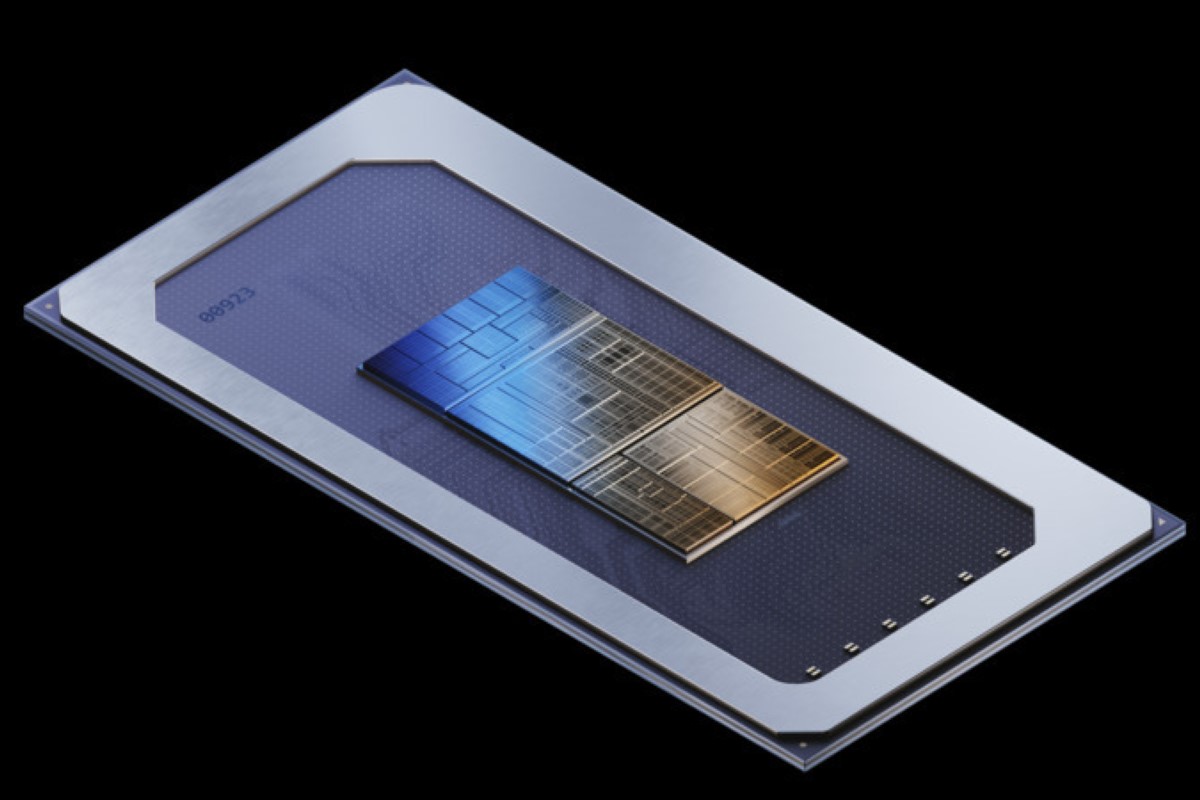
Intel
Intel
Intel
The road to Meteor Lake
Traditionally, an Intel CPU has been divided into two main parts, packaged together: the CPU and Platform Control Hub, or PCH. A Direct Media Interface (DMI) bus connected the two. In this scheme, it’s easy to think of the arrangement as the CPU, and “everything else”: I/O, memory, and so on. (It’s not that clear-cut, but you get the idea.)
Intel’s new tiled arrangement solves several problems. For one, each tile can be worked upon separately, on its own roadmap, and manufactured on the manufacturing process it demands. Intel uses its Foveros technology to connect and stack them all together.
After stalling out on a 14nm manufacturing process for years, Intel’s new plan is to regain manufacturing leadership by striding through five new manufacturing process technologies in four years, faster than it ever has before. But one of the selling points of Meteor Lake — that it’s an “Intel 4” chip — is a trifle deceptive. Only the CPU tile is manufactured on Intel 4. In fact, the graphics tile and SOC tiles are fabricated at manufacturing rival TSMC.
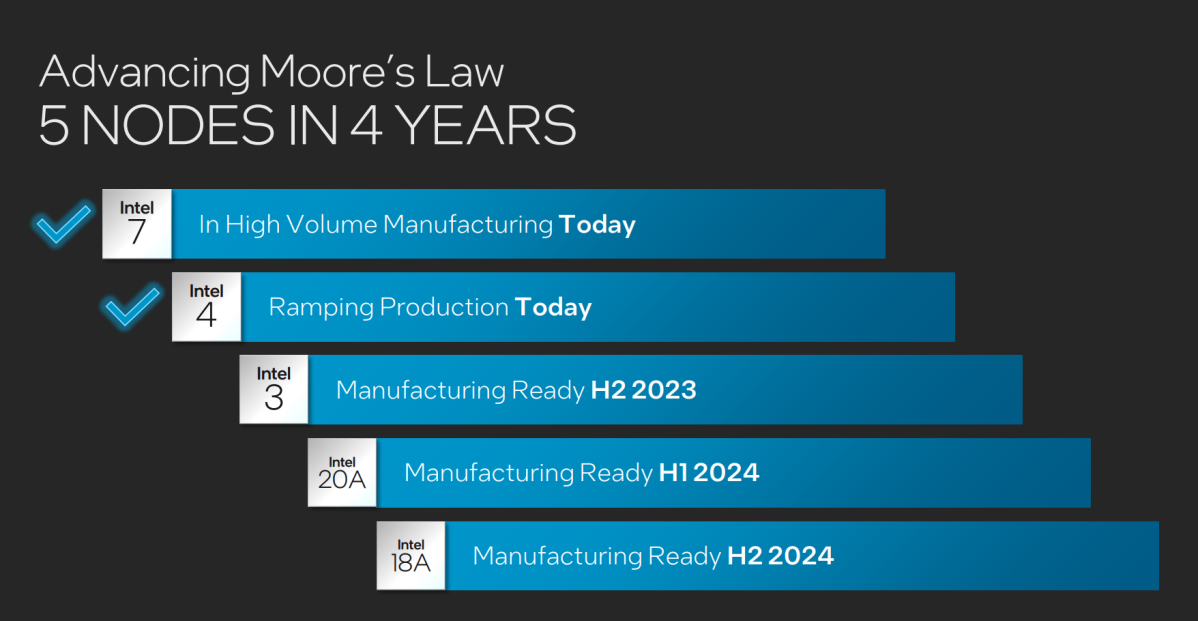
Intel
Intel
Intel
Intel’s new tiles also mean that its logic can be intelligently separated from one another, saving power. Each tile is connected by a fabric that offers approximately 128GB/s of bandwidth.
Intel’s chief executive Pat Gelsinger has referred to Meteor Lake as its “Centrino moment,” hearkening back to 20 years ago when Intel launched the Centrino brand.
Centrino was the first time that Intel bundled a CPU, chipset, and Wi-Fi chip together, but most forget that it was also Intel’s reaction to Transmeta, a failed CPU startup that offered drastically lower power options for laptops. Intel’s legacy CPU-PCH design meant that virtually all tasks touched both chips, powering them up into an active state. Even though Intel then tried to return the CPU and PCH to a low-power sleep state as soon as possible, it still was an inefficient use of power, Intel executives said. By separating Meteor Lake into tiles, Intel can leave the unused tiles in a power-saving deep sleep mode.
According to Michelle Johnston Holthaus, executive vice president and general manager of Intel’s Client Computing Group, customers asked for better power savings. Meteor Lake will deliver the performance of Raptor Lake (or a little more) at roughly half the power, she said.
“‘We love the performance that Intel delivers, but we want it in a more efficient power envelope and we want a more balanced platform,’” Holthaus told PCWorld in an interview, referring to what she said customers have told Intel. “This delivers all that.”

Intel
Intel
Intel
But there’s also a huge secondary bonus, too: manufacturability. Intel’s Intel 4 process is the first to use Extreme Ultra Violet (EUV) lithography, a technology that solves a fundamental problem: The transistors that Intel carves out of its photoresistive silicon wafers are smaller than the wavelengths of light used in the etching process. EUV (which requires a hard vacuum inside the equipment) is seen as the way forward to Intel 4 and beyond.
Intel doesn’t even manufacture all of its tiles itself. Intel’s Meteor Lake GPU tiles are made by TSMC, in its 5nm N5 process; the SOC tiles are made by TSMC in its 6nm N6 process, while the CPU tile is made by Intel on its Intel 4 process. (Intel didn’t say who makes its I/O tile.)
Intel, led by CEO Pat Gelsinger, has pledged to roll out five process technologies in four years, believed to have begun with the Intel 7 process used by the 12th-gen Alder Lake chips. The Intel 4 process also uses an alloy called enhanced copper, a combination of copper and cobalt for superior conductivity, Bill Grimm, a vice president in Intel’s Logic Technology Development group, said.
Even better, Grimm told attendees that the smaller tiles also mean that they’re easier to actually produce. Small errors in the manufacturing process can make a chip too flawed to ship (a problem that the iGPU-less Intel “KF” series was designed to solve). Smaller tiles also mean more chips can be placed on a wafer.
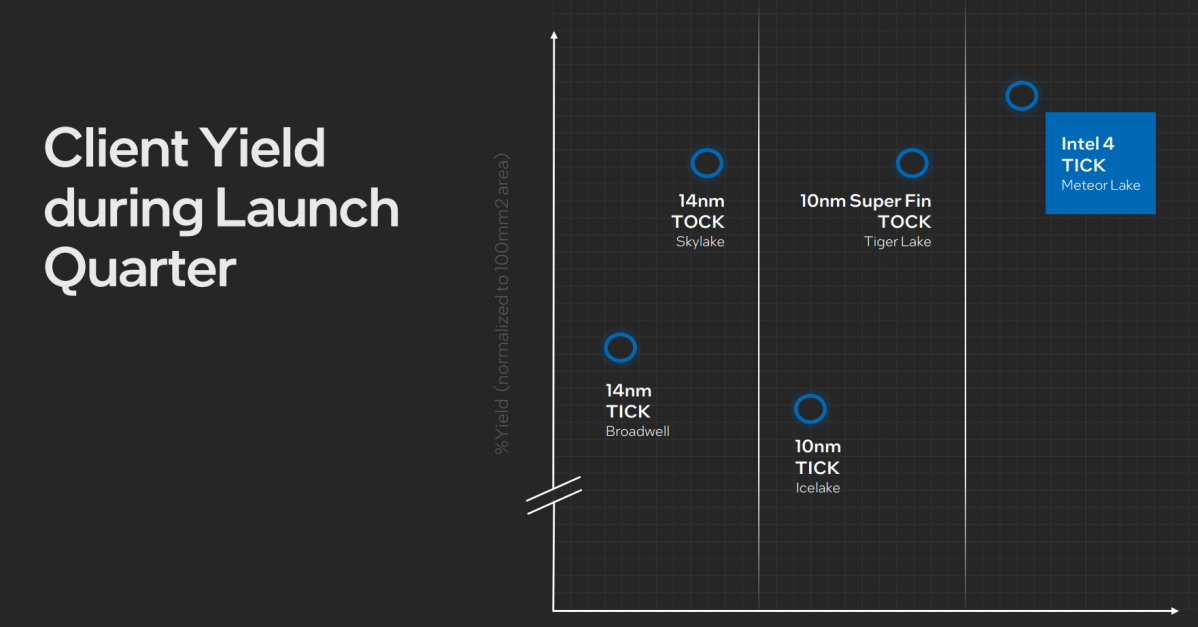
Intel
Intel
Intel
According to Grimm, Meteor Lake will be “the best yielding product at time zero [launch] in more than a decade.” Intel expects that Meteor Lake will see better yields than either any 14nm or 10nm chips, he said. That’s probably good news for the availability and price at which Intel sells Meteor Lake to laptop makers.
Meteor Lake’s CPU tile
As with the 13th-gen Raptor Lake, Intel’s 14th-gen CPU tiles consists of two major parts: the performance cores (P-cores), now known as Redwood Cove, and the new efficiency cores (E-cores,) code-named Crestmont.
We really don’t know that much about what differences there are between Raptor Lake’s P- and E-cores and those found in Meteor Lake. Redwood Cove, however, does offer improved performance efficiency and improved bandwidth, with a larger, though undisclosed level-2 cache.
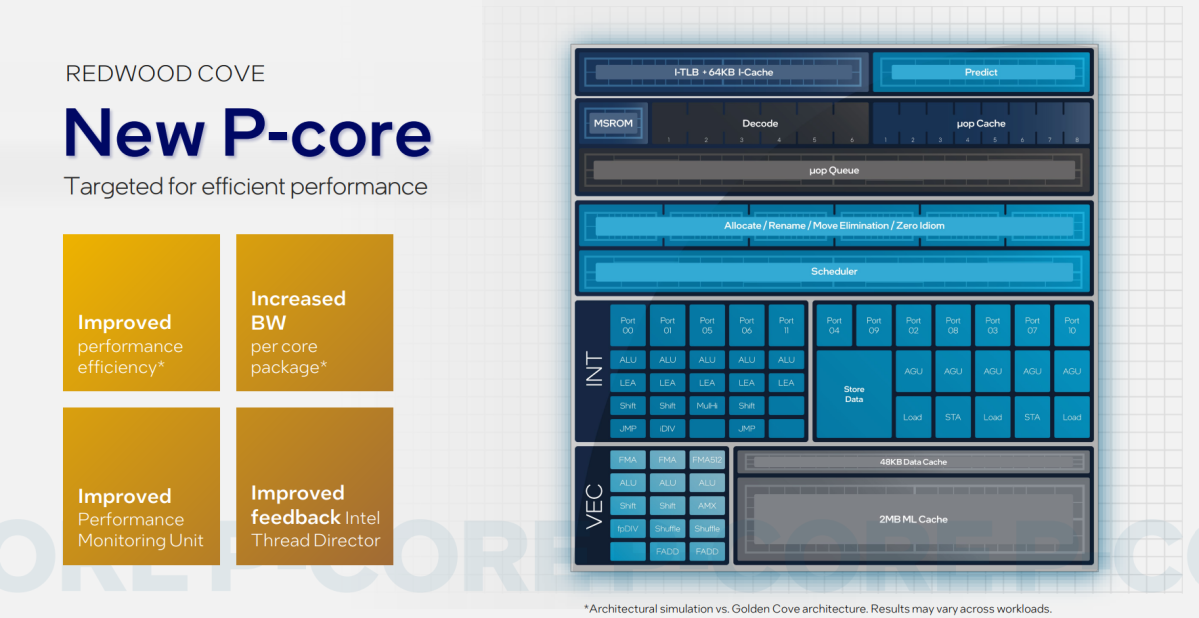
Intel
Intel
Intel
Intel also did not disclose anything about Redwood Cove’s performance improvements. Rajshree Chabukswar, an Intel fellow in its client systems and software division, however, said that Crestmont’s performance improvements are between 4 to 6 percent faster in terms of instructions per clock versus Raptor Lake. (An IPC improvement means that, if Raptor Lake and Meteor Lake were to run at the same speed, Meteor Lake’s Crestmont E-cores would run 4 to 6 percent faster.)
Intel isn’t revealing the various Meteor Lake configurations, but it did show off one during its Tech Day presentation.
“For demonstration purposes during our Tech Day presentation, we showed a 6 [P-cores] +8 [E-cores] configuration,” an Intel spokesman confirmed in an email. “However, we’ll be sharing additional product details closer to launch — including specifications, features, configurations, and performance data.”
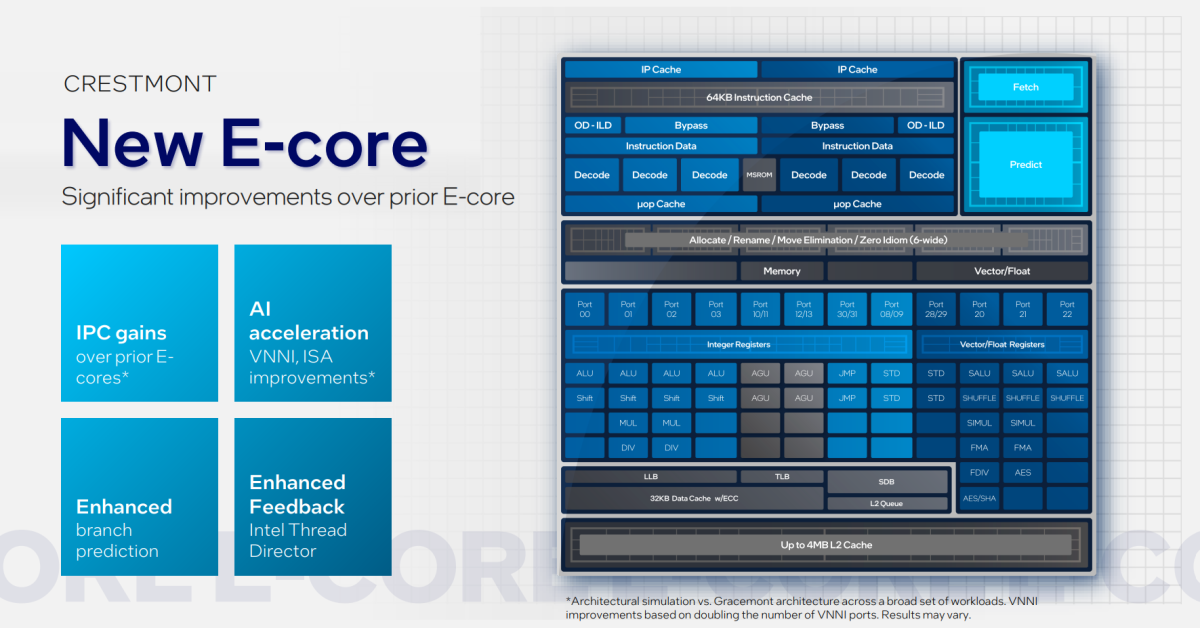
Intel
Intel
Intel
To be fair, we don’t even officially know if Intel will ship a desktop version of Meteor Lake, which some call Meteor Lake-S. As for a rumored desktop “Raptor Lake Refresh” chip, Intel didn’t disclose that chip’s existence, either. We can hope that Intel supplies some additional clarifications this week at its Innovation conference.
Meteor Lake’s SOC tile: What low-power E-cores mean to you
One feature that’s not on the CPU tile are Meteor Lake’s new low-power E-Cores, and that was a deliberate choice.
Meteor Lake’s two new low-power E-cores are contained within the SOC tile, Meteor Lake’s most complex in terms of its array of functions. While the CPU tile contains the CPU cores, the SOC tile is essentially the old PCH, housing the vast majority of Meteor Lake’s secondary functions. Here, you’ll find the low-power E-cores, the new NPU AI engine, as well as the display engine, PCI Express, and more.
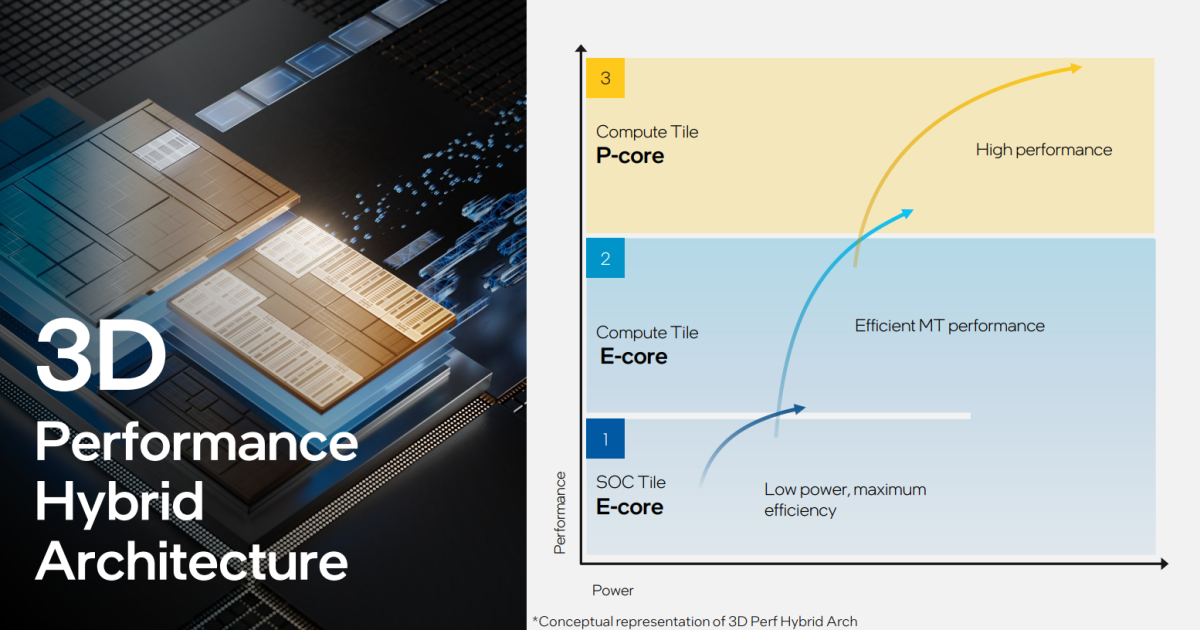
Intel
Intel
Intel
Why put low-power E-cores here? Again, that’s part of Intel’s low-power plan: By separating the low-power E-cores from the CPU tile, that means that only the SOC tile (or a specific portion of it) needs to be awoken into an active power state. That saves power, extending the laptop’s battery life.
So what is a low-power E-core? Perhaps a little lamely, it’s a “new” E-core, a different version of the Gracemont architecture. Recall that E-cores were originally designed for low-power tasks. The new low-power E-cores are designed for what executives referred to as background “IT tasks,” and it’s not clear what those are, entirely. Nor do we know how “low power” these new cores are.
One rather shocking example of what those “IT tasks” entail, however, was when Intel executives used a low-power E-core to play back Tears of Steel, the open-source video file that we use to measure a laptop’s battery life. That’s impressive!
Historically, playing back video demanded the attention of the entire CPU up until about 2017. Then, in Lakefield and Alder Lake, Intel began assigning that task to E-cores and P-cores. Now, video playback has migrated to a tiny portion of Meteor Lake. Imagine how often you play back video. The battery life of laptops should increase dramatically just based upon this task alone.
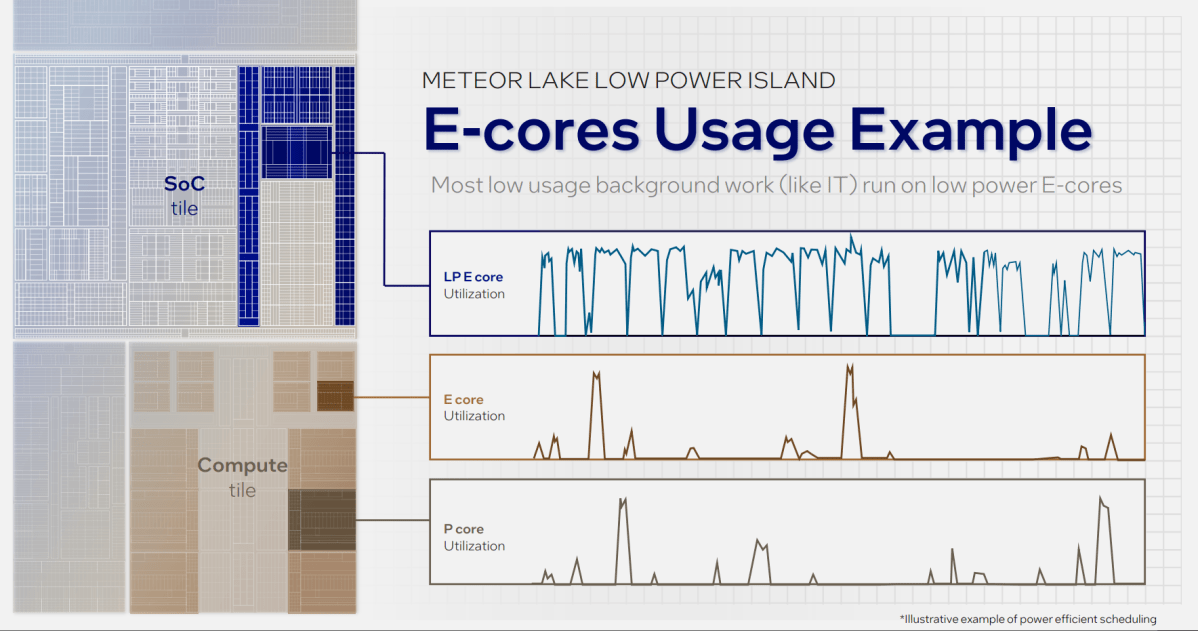
Intel
Intel
Intel
Meteor Lake’s Thread Director makes power, not performance, the priority
Intel has also massively altered Thread Director, the mechanism by which threads or workloads are shunted between cores, within Meteor Lake. Windows or Linux understands what needs to be done and instructs the CPU to take over. That job is then handed to Thread Director. In Thread Director 2, running on the Core i9-13900K, tasks were routed to the performance cores first, then shunted to the E-cores if needed.
In Meteor Lake, it’s the opposite: Threads are first assigned to the low-power E-cores, then the full-power E-cores, and lastly to the P-cores. Thread Director assigns tasks different priorities and then assigns the tasks accordingly. (The tasks are rated not on their performance, but by other characteristics: “0” is “idle,” “2” is “sustained,” and “3” is “bursty.”)
And Intel is serious about this: If a low-power E-core finishes a task and is freed up, an available thread will be pushed to it, even if a P-core is available, Chabukswar said. Even in a situation where a P-core is free, and Intel’s Thread Director is optimized for performance (perhaps via the Windows power slider), tasks will be assigned to the E-cores first, she said.
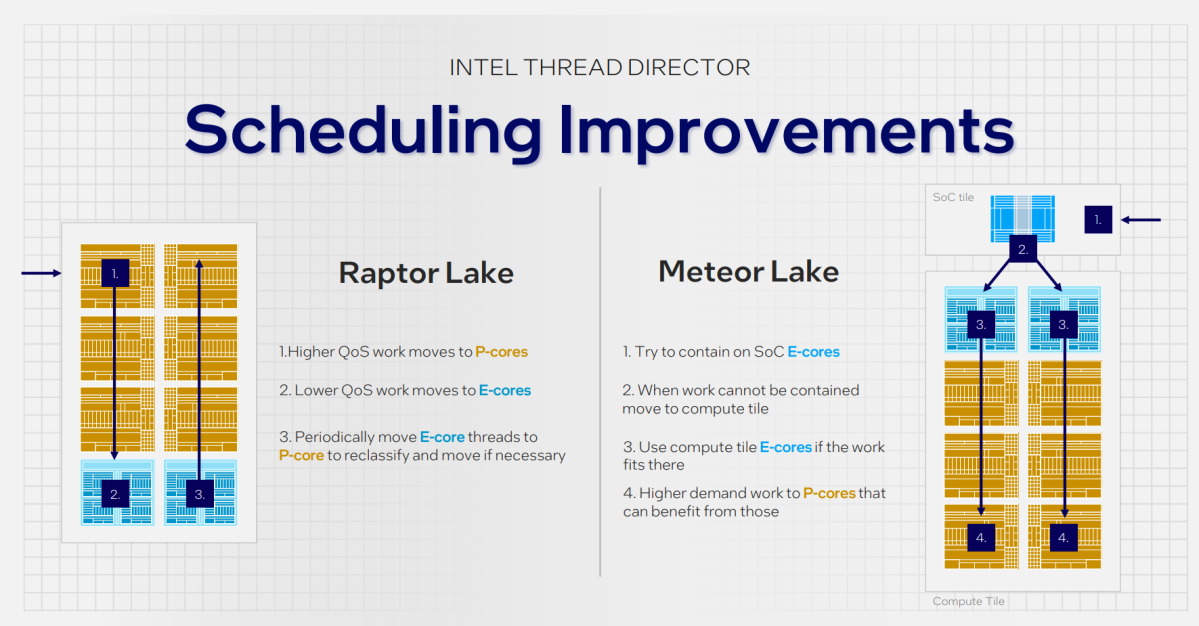
Intel
Intel
Intel
We’ve gone down this road before. Though Intel appears to be able to adjust Thread Director as a policy, we don’t know whether it will. Could a gaming-optimized laptop feature predominantly P-cores, with Thread Director routing threads to the P-cores first?
Chabukswar agreed that Thread Director could be adjusted for the needs of gaming. What isn’t entirely clear is whether there will be a performance penalty for starting a gaming thread, for example, on a low-power E-core, then stepping it through to an E-core and then to a P-core — rather than recognizing that it needed a P-core to begin with.
Intel already disclosed some of its power-management plans before today. At the Hot Chips conference in August, Intel disclosed that it would use “AI” on Meteor Lake to determine how a user interacts with a common task like opening a web page.
By quickly shifting threads to the right cores and then dropping into an idle state, Intel believed it could save 10 to 20 percent in energy without impacting the user experience. But Meteor Lake won’t learn from you: Instead, Intel is taking an average of sorts from what the machine-learning algorithm has learned from its test users.
Intel executives also disclosed that they’re working closely with Microsoft, so that basic Windows functions can be assigned to the right cores.
Meteor Lake’s SOC tile: AI arrives on your PC via the NPU
The SOC tile is also home to what Intel calls the NPU, or AI block. In 2022, Intel CEO Gelsinger confirmed that AI was coming to Meteor Lake, launching the “AI PC era.” According to Holthaus, Intel will ship “millions” of these AI PCs. Incidentally, this NPU will be on all versions of Meteor Lake, Intel confirmed.
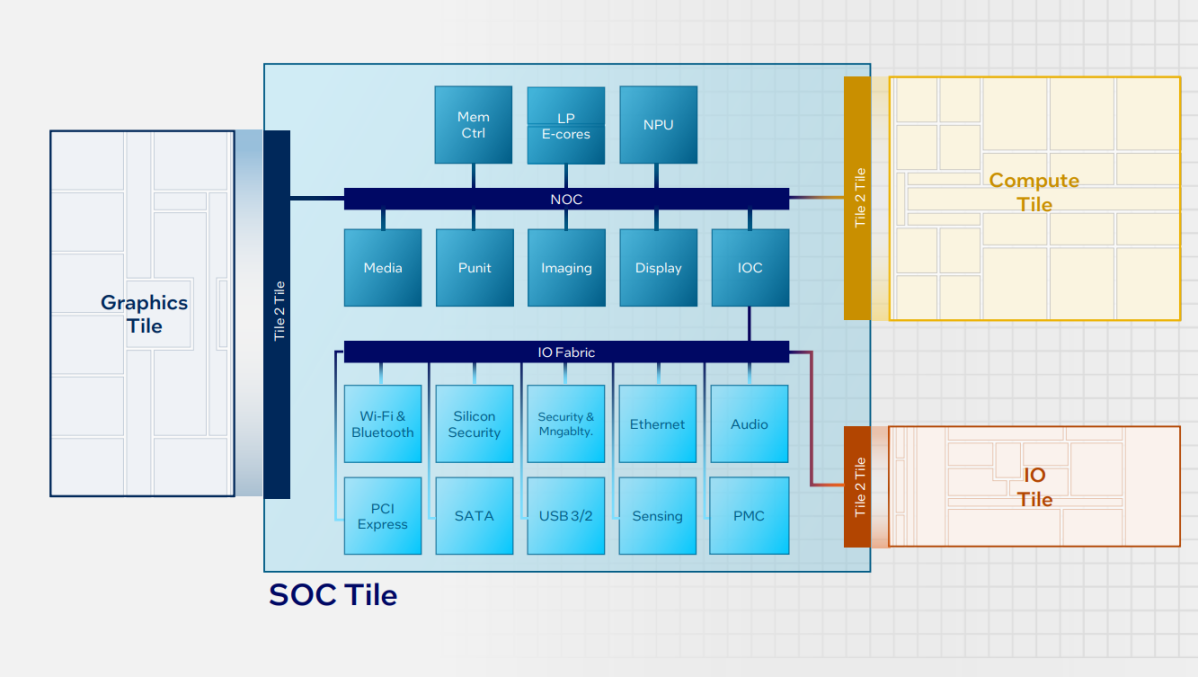
Intel
Intel
Intel
Intel is actually on its third generation of AI: The first generation it bought from Movidius in 2016, later building discrete cards into some PCs like the Samsung Galaxy Book3 Ultra that enable those PCs to do background blurring and noise filtering via what’s known as Windows Studio Effects. (While Windows Studio Effects use the Movidius technology, Zoom, Teams, Google Meet, and others simply use your PC’s CPU or GPU instead.)
What Intel is trying to do is position the PC for future AI applications, even if it doesn’t know exactly what they’ll be. Tom Petersen, an Intel fellow, showed off Stable Diffusion, an AI art generator. He also demonstrated a plugin for audio editor Audacity that not only separated the vocals from the backing instruments, but later altered that instrumental style using a text prompt. Intel’s goal appears to be the tide that lifts all boats, accelerating AI APIs like WinML, DirectML, and its own OpenVINO inference engine.
“Our goal is to democratize AI,” said Tim Olson, general manager of SOC design for Intel, in a separate presentation.

Intel
Intel
Intel
The NPU is one part of that. Intel’s NPU includes a pair of neural compute engines, each with two VLIW Shade DSPs inside, with inference engines capable of up to eight instructions per cycle. Even for consumers used to parsing the number of cores per chip, base clocks, and turbo clocks, this won’t make a lot of sense. What Intel is trying to convey is that AI requires a ton of multiply-accumulate (MAC) instructions per cycle, and that those engines can perform 2,048 MAC calculations each.
Is that good? Is that bad? We really don’t know. We don’t really have a general point of reference for what makes for “good” AI, in terms of specs or benchmarks, and Intel executives gave us the idea that they’re trying to work that out, too.
Intel’s secret sauce, though, isn’t just the AI NPU, but how the CPU, GPU, and NPU can all help assist each other. Take the following example. Running 20 iterations of Stable Diffusion, Intel tried various combinations: performing all of the calculations on the CPU, all on the GPU, all on the NPU, and a combination of all three. Performing them all on the NPU took 20.7 seconds and 10 total watts, the most efficient use. But performing them all on the GPU and NPU finished the task in 11.3 seconds, consuming 30W.
Which is better? Ideally, the user and/or Windows will make that decision. But it’s not a straightforward, simple solution.
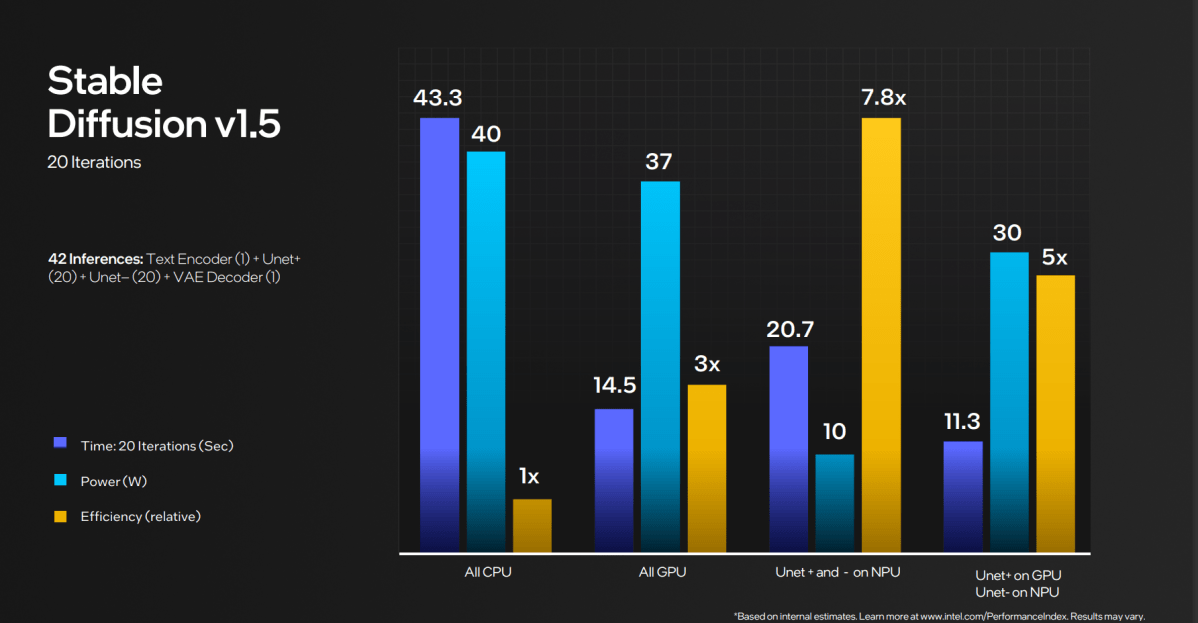
Intel
Intel
Intel
Intel is also integrating what it calls the DP4A instruction into the GPU, a GPU instruction specifically designed to accelerate AI.
Meteor Lake? Try Media Lake
Remember, Intel’s not disclosing all of what Meteor Lake hides. We know, for example, that PCI Express Gen 5 (PCIe 5) will be supported, but not how many lanes. Ditto for what flavor of Ethernet the chip will support, or the number of USB bus connections. It appears, though, that the chip will support Thunderbolt 4, but not the upcoming 80Gbps version, Thunderbolt 5.
Intel executives also said that the chip would support DDR5 and LPDDR5, but we don’t know for certain if that excludes DDR4 or LPDDR4. Intel has confirmed that both Wi-Fi 6e and Wi-Fi 7 will be supported, however, giving gobs of headroom for persistent wireless connectivity.
Intel essentially separated the SOC tile into two halves, with an I/O fabric connecting all of the I/O (Ethernet, Wi-Fi, and so on) to the I/O tile. A separate NOC fabric connects the low-power E-cores, NPU, and display controller. (A small I/O controller connects both halves.) Again, this was done to minimize power consumption, as each half can work as independently as possible.
Intel’s imaging and display blocks support HDMI 2.1, DisplayPort 2.1, and embedded DisplayPort 1.4. One important feature that Intel is disclosing is how many displays Meteor Lake will support: up to a single 8K60 display (with HDR), or four 4K60 displays, again with HDR. And if you’re a gamer, Meteor Lake will support a single 1080p or 1440p display at 360Hz. That’s a big deal.
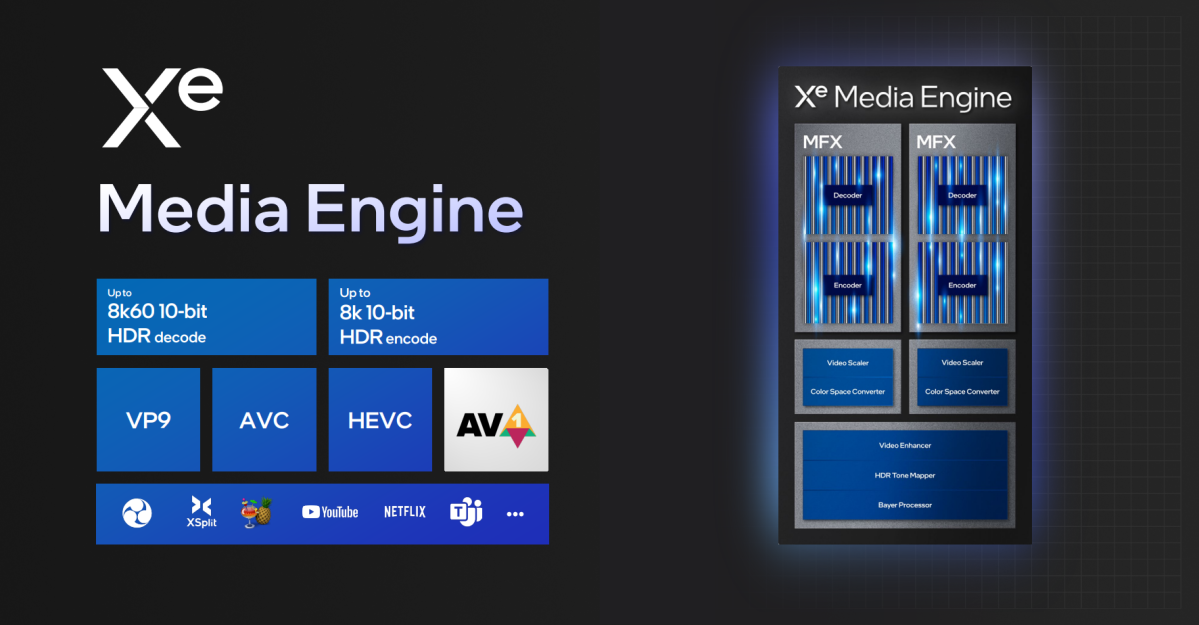
Intel
Intel
Intel
The media engine will support 8K60 10-bit HDR decode and encode, with support for various codecs. Among them is the open-source AV1 codec, which has already demonstrated impressive encoding results running under Intel’s standalone Arc chip.
Intel also put a small twist in its display engine to save power: If the same frame happens to repeat, Meteor Lake is smart enough that it can leave the frame off entirely. Two of its four display pipelines are also optimized for low power, which Petersen highlighted as a potential solution for a virtual keyboard on a foldable device.
Meteor Lake’s graphics tile: Ray tracing in an integrated GPU?
While Intel’s debut in the PC graphics space provided a welcome third competitor, the company’s efforts in both the integrated and discrete graphics market have had their issues. Meteor Lake and what Intel calls its XeLPG graphics block combine elements of both markets, updating the Xe (or XeLP) integrated GPU that has been inside Core processors for the last few years. Essentially, Intel is taking as much as it can from its standalone Arc GPUs and putting it inside the integrated Meteor Lake GPU.
“We’ve taken all the goodness from our XeHPG architecture and put it into our XeLPG architecture,” Petersen said. Even better, by placing graphics on a separate tile, Intel can mix and match graphics performance for the market it’s pursuing, Petersen added.

Intel
Intel
Intel
According to Intel’s Petersen, Intel is targeting twice the performance of the earlier Xe core, and twice the performance per watt, too. Intel is increasing the XeLPG’s clock speeds, dedicating more silicon to it, and making it more efficient.
Finally, Intel is bringing in the eight Xe cores from the Arc A770 as well as eight ray-tracing units into Meteor Lake. Yes, that means ray tracing is now part of the basic integrated GPU, and not just a discrete chip. Petersen did admit, however, that it would be up to software developers to take advantage.

Intel
Intel
Intel
Put simply, compare our earlier deep dive into the XeHPG architecture and it all looks extremely similar: Inside each “slice” of the XeLPG core are four Xe cores, with 16 256-bit vector engines and 192KB shared L1/SLM cache. Intel supports DirectX 12 Ultimate natively.
There are new bits, too. The new architecture supports FP64 instructions — Arc doesn’t — plus out-of-order sampling, and Intel’s software partners told Intel that including FP64 would do wonders for software compatibility, Petersen said.
While Intel declined to share actual game performance data, Petersen did agree to share some of its “micros,” or internal abstract performance tests. Measurements ranging from triangle draw rate (2.6X over the XeLP found in Raptor Lake) to depth test rate (6.6 times Raptor Lake) are one indication that Intel believes that its new Xe cores are head and shoulders above its older technology. Intel also showed off Forza Horizon 5 running on the Meteor Lake hardware, but didn’t disclose the resolution or graphics settings.

Intel
Intel
Intel
Meteor Lake’s XeLPG also supports XeSS, Intel’s answer to Nvidia’s DLSS. Intel’s technology renders the frame at a lower resolution, then supersamples it up to a high-res image.
According to Petersen, this saves energy as well as improves the image; applying XeSS lowers the energy consumed to 526 millijoules as opposed to 863 millijoules. Meanwhile, Peterson showed off frame rates that increased to 1.69X or so when XeSS was turned on.
Finally, Meteor Lake introduces what Intel calls Endurance Gaming, which will use the Intel Arc Control application for power management. The app talks directly to Intel’s mobile drivers, moderating performance and improving efficiency; in a “regular gaming” mode, Arc Control, could allocate 28W to the entire system, including the CPU and GPU. In Endurance Gaming, that could be cut to a total of 10W, giving just 1W to the CPU. Intel’s Petersen said that the game Rocket League could be run at 30 frames per second at less than 1W of power.
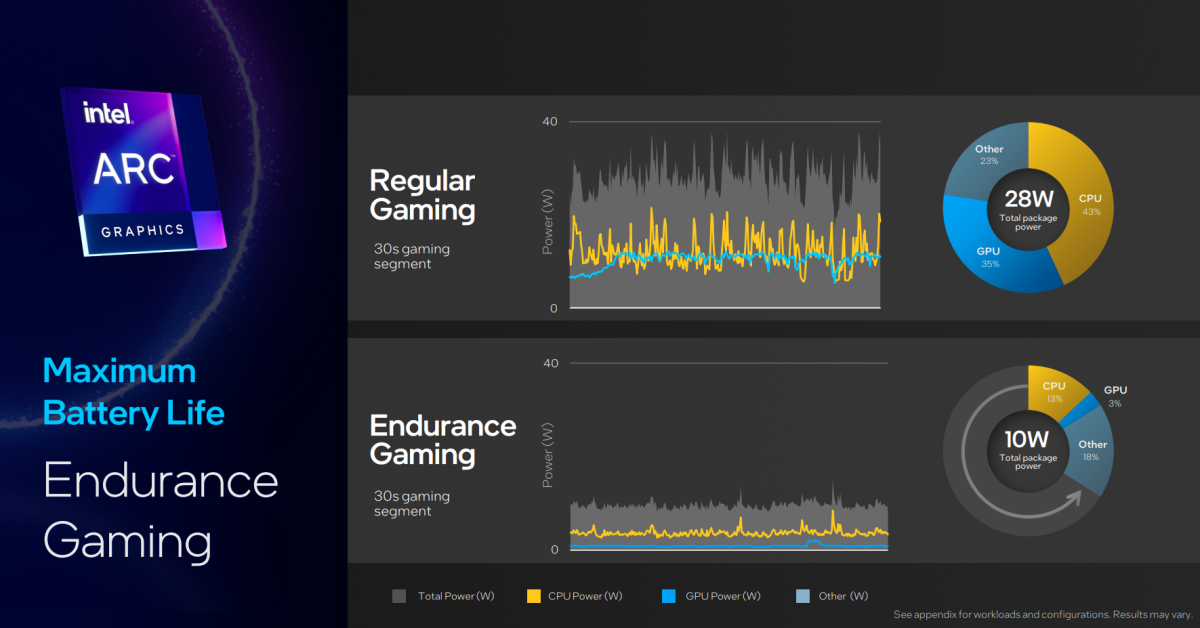
Intel
Intel
Intel
Appendix: Meteor Lake’s I/O tile
We’re not going to talk about the fourth I/O tile, precisely because Intel barely touched upon it. With most of the “I/O” functions actually contained within the SOC tile, some of the additional, market-specific functionality may live here. What that will be, and what it will look like, isn’t really known.
Intel confirmed that Meteor Lake will have Thunderbolt 4, not 5, connectivity to external Thunderbolt docks, as well as external USB functionality — no surprises there. But Intel fellow Mikal Hunsaker also indicated that the I/O tile could also be reworked to meet the needs of the market.
One question that leaves us with: How quickly will each of these tiles be overhauled? We can’t help but think a little of how Windows apps like Photos are now on their own development cycle, and not tied to any particular Windows release. It seems like Intel may adopt a similar approach.
Intel’s system-level technologies
Intel, naturally, doesn’t just manufacture PC silicon — its Arc software is proof of that. But Intel also outlined some of the system-level initiatives it would focus on with Meteor Lake platforms, too:
Wi-Fi 7: Intel’s BE200 radio chip (aka Gale Peak 2) will be used alongside Meteor Lake platforms. It supports Bluetooth LE with lower power and latency, as well as Wi-Fi 7 — with speeds of up to 5.76Gbps, it’s theoretically faster than most implementations of wired Ethernet.
Intel Unison: Intel’s Unison software is like Windows’ own Your Phone, but it’s the most effective way to get the iPhone’s iMessage communication on your PC. It’s much more powerful with Android, though, and the updated Unison software will support extending your laptop’s screen onto an (Android) tablet, as well as more effective wireless communication that can take advantage of multiple wireless connections.
Intel Cool, Quiet, Performant: Part of Intel’s Evo program is working with PC makers to help co-engineer their notebooks and desktops. Intel showed off its dual-channel hyberbaric flow design that it patented, and can be used with laptops. It also developed an ultrathin vapor channel, also patented, that it can supply to notebook makers. Specific software to optimize fan speed and analyze workloads to shift performance up and down are also options.

Intel
Intel
Intel
The fan speeds controls were designed with acoustics in mind, so they’ll scale up just under the point where you’ll find the fan noise annoying. The workload analysis software appears to be, or be related to, the AI-powered power-management techniques Intel showed off previously at Hot Chips.
Conclusion
Intel may have presented us a massive amount of information about its Meteor Lake chip, but we still don’t know that much about the 14th-gen Core: when exactly it will ship, its clock speeds, how it will be configured for its various markets, and so on. Interestingly, Intel has splintered its Xeon server chip roadmap into two different forks: Sierra Forest, made up of all E-cores, and Granite Rapids, consisting of all P-cores. Intel’s tiled architecture should allow it some of these options, if it so chooses.
We still await AMD’s response in the notebook space, and even Qualcomm’s answer with its Oryon (Nuvia) technology. But Intel still ships the vast majority of all laptop CPUs, making it the dominant player in the space. You’ve likely just read the specific details of your next laptop’s microprocessor.
Updated at 9:23 AM on Sept. 19 with additional details. Corrected on October 12, 2023, with a reference to the “Raptor Lake Refresh” chip.
(Disclosure: Intel paid for airfare, room, and board at the event, which it called the Intel Tech Tour. PCWorld accepted Intel’s offer only to gain access to the event. Intel did not ask for, nor did PCWorld provide, any editorial oversight to Intel representatives.)
Author: Mark Hachman, Senior Editor

As PCWorld’s senior editor, Mark focuses on Microsoft news and chip technology, among other beats. He has formerly written for PCMag, BYTE, Slashdot, eWEEK, and ReadWrite.






